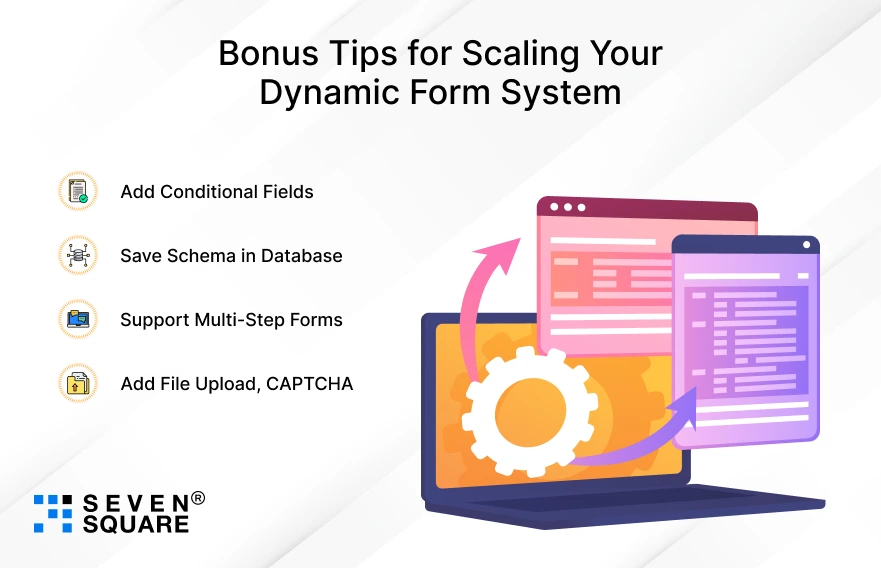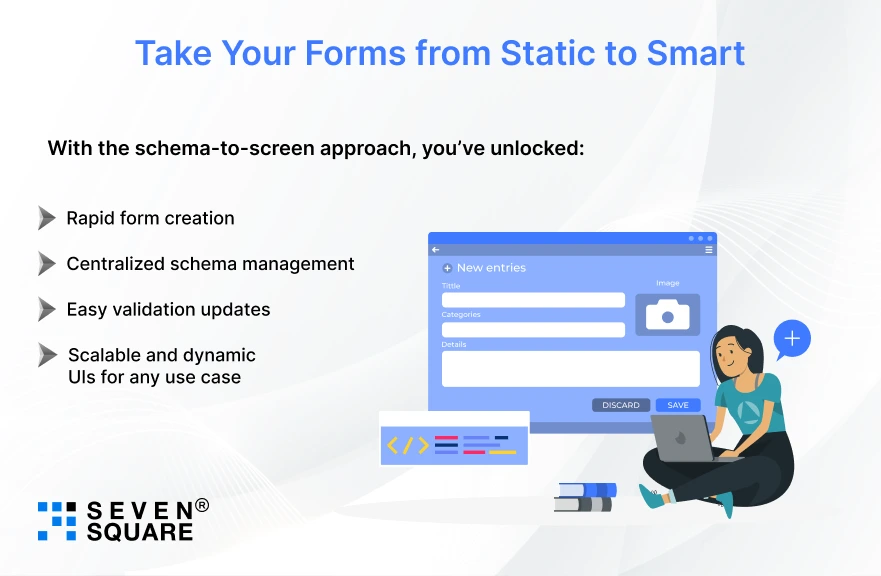Creating forms is one of the most common tasks in web development.
Especially when building admin panels, onboarding workflows, surveys, CRMs, or any data-heavy application.
But building forms the traditional way, writing HTML manually for every input, and adding static validation logic can be painful, repetitive, and error-prone.
That’s where Node.js dynamic forms come in.
With form generation in Node.js, you can define your form structure using a schema and generate it dynamically in both the backend and front end.
No more duplicating code for every form!
In this blog, you’ll learn how to:
- Create dynamic forms using schema definitions.
- Add real-time form validation using express-validator or Joi.
- Render forms dynamically using EJS or React.
- Download and run the full working project from GitHub.
Whether you’re a backend developer, product founder, or agency building form-heavy apps, this blog will save you time and make your forms smarter.
What Is Dynamic Form Generation in Node.js?
Dynamic form generation in Node.js means creating forms based on a predefined schema or data structure instead of writing the HTML manually.
You define the form fields, input types, labels, validation rules, and options in a schema (like JSON), and your app generates the form and its validation dynamically.
Real-World Example:
Imagine building a survey builder or a settings panel. With schema-based generation:
- You don’t need to code every form page manually
- You can reuse one form engine for multiple use cases
- You can even let admins define custom fields via UI
Using a schema to generate forms from data also makes your app more flexible and maintainable.
Changes in form requirements don’t require front-end or back-end rewrites, just update the schema and you’re done!
Learn to Build Token-Based Authentication in Node.js with JWT.
What are the Tools & Libraries You’ll Need for Dynamic Form Generation & Validation in NodeJs?
To build a robust Node.js form builder with real-time validation, you’ll need the following tools:
Backend Essentials
- Node.js and Express.js: For building the server and handling requests.
- express-validator: Lightweight middleware for validating user inputs.
- Joi (Optional): Schema-based validation library with powerful features.
- JSON Schema or JS Objects: Define field structure, labels, types, and rules.
Frontend (Optional)
- EJS: If you’re using server-side rendering.
- React: If your front end is in React, you can pass the schema via API and render dynamic forms.
These tools combined allow you to generate dynamic forms and validate inputs in a scalable, reusable way.
What is the Step-by-Step Guide to Generate Forms from Schema?
To build dynamic forms in Node.js, the first step is defining your form fields using a schema.
This schema acts as a blueprint for input types, labels, validation rules, and more.
Let’s go through how to generate dynamic forms in Node.js from a simple schema.
Sample Form Schema (JSON/JS Object)
Here’s a sample schema for a basic form with fields: Name, Email, Age, and Country.
// schema.js
module.exports = [
{
name: "name",
label: "Full Name",
type: "text",
required: true,
},
{
name: "email",
label: "Email Address",
type: "email",
required: true,
},
{
name: "age",
label: "Age",
type: "number",
required: false,
},
{
name: "country",
label: "Country",
type: "select",
options: ["India", "USA", "Canada"],
required: true,
}
];
Loop Through Schema to Generate Form Inputs
You can loop through this schema in your Express route or EJS template to dynamically create form fields.
// app.js (Express Setup)
const express = require("express");
const path = require("path");
const schema = require("./schema");
const app = express();
app.set("view engine", "ejs");
app.set("views", path.join(__dirname, "views"));
app.use(express.urlencoded({ extended: true }));
app.get("/", (req, res) => {
res.render("form", { schema });
});
app.listen(3000, () => console.log("Server running on http://localhost:3000"));
<form method="POST" action="/submit" >
< % schema.forEach(field = > { % >
<label ><%= field.label % > < /label >
<% if (field.type === "select") { % >
<select name="<%= field.name % >" >
<% field.options.forEach(option = > { % >
<option value="<%= option % >" ><%= option % ></option >
<% }) % >
</select >
<% } else { % >
<input type="<%= field.type % >" name="<%= field.name % >" / >
<% } % >
<br / >
<% }) % >
<button type="submit" >Submit</button >
</form >
/ Generate form fields dynamically in Node.js from JSON schema /
How to Add Real-Time Form Validation Using express-validator or Joi?
Once your dynamic form is generated, the next step is to validate it based on your schema rules.
For real-time validation in Express.js, we can use express-validator.
How to Add Validation Rules to Schema?
Add a new field called validation in your schema.
{
name: "email",
label: "Email Address",
type: "email",
required: true,
validation: {
isEmail: true,
errorMessage: "Enter a valid email"
}
}
Backend Validation Using express-validator
Install the package:
npm install express-validator
// validation.js
const { body } = require("express-validator");
const schema = require("./schema");
function buildValidationRules() {
return schema.map(field => {
let rule = body(field.name);
if (field.required) {
rule = rule.notEmpty().withMessage(`${field.label} is required`);
}
if (field.validation?.isEmail) {
rule = rule.isEmail().withMessage(field.validation.errorMessage);
}
return rule;
});
}
module.exports = buildValidationRules;
// Add in app.js
const { validationResult } = require("express-validator");
const buildValidationRules = require("./validation");
app.post("/submit", buildValidationRules(), (req, res) => {
const errors = validationResult(req);
if (!errors.isEmpty()) {
return res.status(400).send(errors.array());
}
res.send("Form submitted successfully!");
});
This setup allows dynamic, schema-based Node.js form validation using express-validator.
Frontend Rendering: Connect Schema to Screen (EJS or React)
To render dynamic forms in Node.js, you pass the schema to the frontend and build inputs using logic (as shown earlier).
Here’s how to make the Node.js dynamic form UI user-friendly.
Passing Schema to Frontend
If you’re using server-side rendering (EJS):
res.render("form", { schema });
If you’re using React, send schema via API:
app.get("/api/schema", (req, res) => {
res.json(schema);
});
UX Tips for Better Form Flow
- Group related fields using field sets.
- Add placeholders and inline validation messages.
- Show real-time feedback (e.g., “Valid email ✔”).
- Handle backend errors gracefully and display them next to relevant fields.
Example React Snippet to Render Form
// Assuming schema is fetched from /api/schema
schema.map(field => {
if (field.type === "select") {
return (
<label key={field.name}>
{field.label}
<select name={field.name}>
{field.options.map(opt => (
<option value={opt} key={opt}>{opt}</option>
))}
</select>
</label>
);
}
return (
<label key={field.name}>
{field.label}
<input type={field.type} name={field.name} required={field.required} />
</label>
);
});
Explore full GitHub Code for Dynamic Form Generation and Validation in NodeJs.
Bonus Tips for Scaling Your Dynamic Form System

Once you get the basics right, you can take your dynamic form system to the next level with these tips:
- Add Conditional Fields: Show/hide fields based on other field values (e.g., if user selects “Other”, show a text box).
- Save Schema in Database: Allow admins or users to define custom forms that your system can render on the fly.
- Support Multi-Step Forms: Break large forms into wizard-style steps with progress tracking.
- Add File Upload, CAPTCHA, etc.: Extend schema to handle file inputs, reCAPTCHA, and more for robust data collection
By implementing these, you’ll be able to build scalable dynamic forms in Node.js suitable for enterprise apps, SaaS products, and internal tools.
Take Your Forms from Static to Smart

You’ve just built a fully working schema-based dynamic form system in Node.js, complete with real-time validation and frontend rendering.
No more hardcoded fields. No more repetitive validation rules.
With the schema-to-screen approach, you’ve unlocked:
- Rapid form creation
- Centralized schema management
- Easy validation updates
- Scalable and dynamic UIs for any use case
If you’re building a form-heavy application, a CMS, or a dynamic dashboard, Node.js dynamic forms can save your team weeks of development time.
Want to create Dynamic NodeJs Form? Contact Us Now!
FAQs
- Dynamic forms in Node.js are forms that are generated automatically based on a schema or data structure (like JSON).
- Instead of manually coding each input field, developers use logic to build dynamic forms by looping through schema definitions to make the form generation process reusable, scalable, and easier to manage.
- Yes. With real-time validation in Express.js, you can apply validation rules dynamically based on your form schema.
- Using libraries like express-validator or Joi, you can validate inputs like text, email, numbers, and dropdowns on the server side before storing or processing the data.
- To render a dynamic form UI in Node.js, pass the schema to a templating engine like EJS or an API endpoint for React.
- Then loop through the schema to create appropriate input fields.
- This makes your Node.js dynamic form UI consistent, easily editable, and developer-friendly.
- In your schema, define a field with “type”: “select” and include an options array.
- While rendering the form, check the field type and use a <select> tag to loop through the options.
- This approach allows you to dynamically generate dropdowns based on any data source, even from a database.